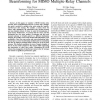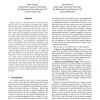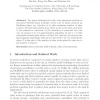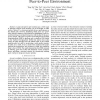110
click to vote
TSP
2010
14 years 7 months ago
2010
This paper is concerned with the performance of a regenerative relaying protocol on fading wireless channels with imperfect channel knowledge at the receivers. Assuming a single s...
127
Voted
GLOBECOM
2007
IEEE
15 years 4 months ago
2007
IEEE
In this paper, we consider a MIMO wireless relay network where communication between a source and a destination node is assisted by multiple relay nodes using the Amplifyand-Forwar...
113
Voted
CSE
2009
IEEE
15 years 4 months ago
2009
IEEE
Existing work has been focused on minimizing the number of relay nodes to maintain the connectivity of a sensor network. However, we believe replacing batteries for nodes or redepl...
125
click to vote
ACSAC
2007
IEEE
15 years 4 months ago
2007
IEEE
Relay nodes are a potential threat to networks since they are used in many malicious situations like stepping stone attacks, botnet communication, peer-to-peer streaming etc. Quic...
132
Voted
COCOON
2005
Springer
15 years 6 months ago
2005
Springer
The paper addresses the relay node placement problem in two-tiered wireless sensor networks. Given a set of sensor nodes in an Euclidean plane, our objective is to place minimum nu...
124
Voted
VALUETOOLS
2006
ACM
15 years 6 months ago
2006
ACM
— Considered is a mobile ad hoc network consisting of three types of nodes (source, destination and relay nodes) and using the two-hop relay routing protocol. Packets at relay no...
111
Voted
IWCMC
2006
ACM
15 years 6 months ago
2006
ACM
Receiver-side relay election has been recently proposed as an alternative to transmitter-side relay selection in wireless ad hoc networks. In this paper we study different priori...
106
Voted
IWNAS
2006
IEEE
15 years 6 months ago
2006
IEEE
Recent work in mobile ad hoc networks, simply MANETs, has drawn attention to the mobility capability of each node. In [5], it is proved that the optimal positions of the relay nod...
118
click to vote
INFOCOM
2006
IEEE
15 years 6 months ago
2006
IEEE
Abstract— To increase reliability and robustness of missioncritical services in the face of routing changes, it is often desirable and beneficial to take advantage of path diver...
84
Voted
INFOCOM
2006
IEEE
15 years 6 months ago
2006
IEEE
— Large-scale peer-to-peer systems span a wide range of Internet locations. Such diversity can be leveraged to build overlay “detours” to circumvent periods of poor performan...




